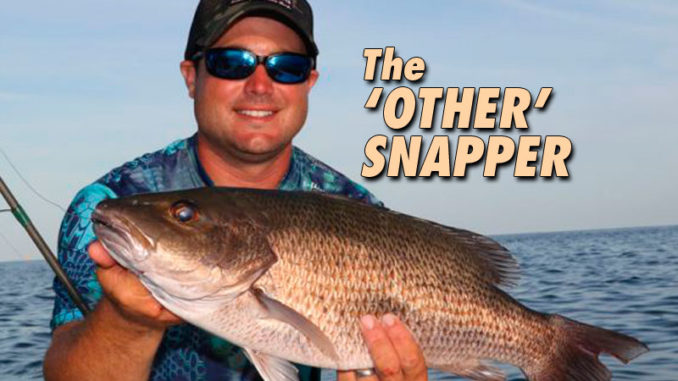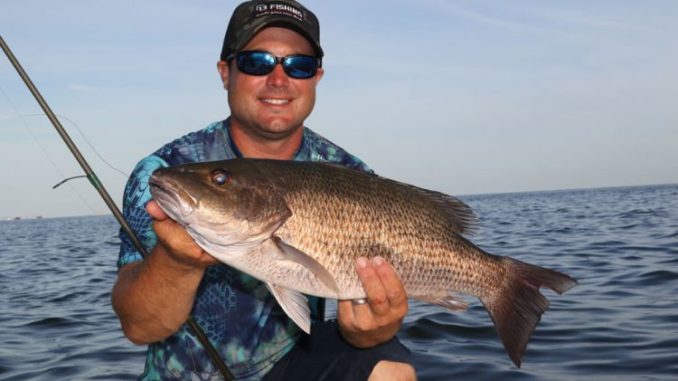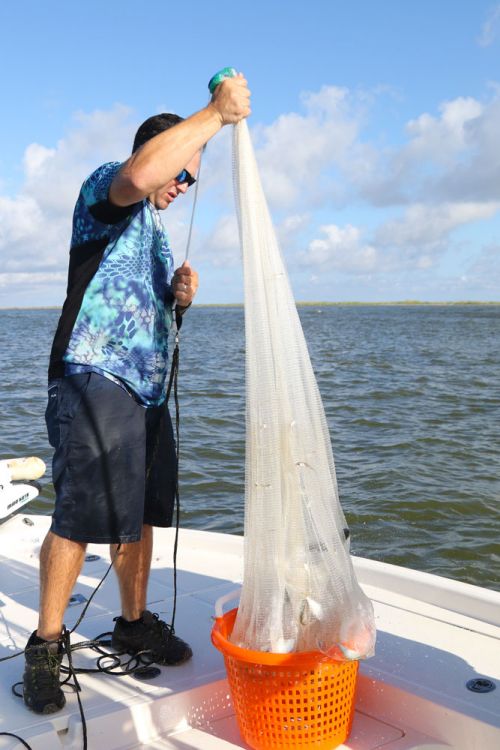
Mangroves may not get all the publicity their rosy relatives receive, but they taste great — and you can catch 10 per day year-round. Here’s how one Buras guide fills the box.
It took us all day to find our targets, but Capt. Ross Montet delivered.
In fairness, the day presented challenging conditions, but let’s just say that when the peach ripened, the top-shelf guide with bloodhound instincts put us in position to take a big bite.
Our August outing had a singular focus — snapper; but not the one that most folks probably envision. While those rosy beauties known as American red snapper may hold a higher ranking among sport-fishing enthusiasts, Montet had set his sights on mangrove snapper — a sporty and tasty option with considerably more availability, both in season and bag limit.
“As far as food quality, mangrove snapper are pretty close with red snapper,” he said. “The other thing is our limit on mangrove snapper is 10 a person; our limit on red snapper is two a person.”
Leaving Buras-based Cajun Fishing Adventures, we launched at Joshua’s Marina and ran out the Empire Waterway. Shrimpers crisscrossed the area with muddy wakes, as oystermen worked their bivalve bounty.
Our first priority was loading up with bait. We’ll discuss the particulars later (see the Pogy Prudence sidebar), but suffice it to say your time is well spent rounding up fresh offerings.
Weather influence
Like all angling pursuits, meteorological factors can greatly impact snapper fishing. This day’s clear, flat conditions made for easy running, but those bright skies put the shut-mouth on our quarry. We nearly ran Montet’s Skeeter bay boat out of gas as we hit a dozen or so rigs where he’s caught mangroves in the past; nevertheless, our efforts were largely fruitless. A couple of bluefish, cobia, jacks and a lone red snapper kept us from falling asleep, but the day was shaping up to be a big disappointment.
Montet’s dad, Capt. Jude Montet, was running a similar program that day and frequent VHF correspondence revealed an equally dry effort on his boat. About an hour before sunset, the elder Montet let us know he was packing it in for the day, but his son had that look of half frustration, half determination in his eyes.
“Let’s try one more spot before we head in,” Ross said.
With the blazing hot sun now tempering into a softer warmness, we noticed also that a little breeze was cooling the scene. More importantly, the captain nodded to the chunky clouds forming on the horizon.
“That high pressure’s getting out of here,” Montet said. “Those fish might start biting.”
Fast and furious
Sure enough, about 10 minutes into what would be our final stop, LIVETARGET’s Gary Abernethy came tight on a chunky mangrove snapper that bit a piece of pogy about 20 feet down. Moments later, Jose Chavez of 13 Fishing double over with another nice one. Not to be outdone, Capt. Ross put the brakes on one of the day’s biggest fish to launch us into an all-out snapper slappin’ rally that put a pile of mangroves in the 3- to 7-pound range on ice.

At one point, the action became so intoxicating, I actually put down my camera and grabbed a rod. Two heavy hits connected me with serious snapper, both of which got me into the rig and broke the line. At that point, I was asked to stay in my lane and just shoot pictures — which I did.
Now, such action usually doesn’t take so long to develop, but we were dealt a limiting scenario. When summer days roll out more cooperative conditions, bagging keeper mangroves can be a lot easier. Here are some tips to facilitate your mission.
Find the fish
Just about any Delta rig will hold mangrove snapper, but Montet has found some consistencies.
First, the bigger the rig, the more habitat and food sources, but larger structures also attract more angler eyeballs. That doesn’t necessarily doom a rig’s potential, but just know that you’re fishing for educated fish, while the more modest rigs may hold a stack of overlooked fish.
Another upside of avoiding larger structures is less interference from crew boats. Recreational vessels must give way to these approaches, but all the commotion and prop washing can blow out the snapper bite.
“One thing I like to look for is the (non-operating) rigs. They still have the sound beacons, but there’s no processing on them. I find those rigs have more fish on them because they don’t get messed up by crew boats.”
Higher in the water column
Of the mangrove snapper’s positioning, Montet says this: “I find that mangroves tend to hang closer to the rig and they tend to stay up a little bit higher in the water column than red snapper. You’ll catch them anywhere from just below the surface, to about 40 feet down.”
Something worth noting: The rig that produced our big haul was a manned platform with housing quarters. As Montet pointed out, every evening the kitchen crew dumps table scraps into the water — and the ensuing chum line brings the food chain of baitfish and progressively larger species, including mangrove snapper, topside.
Once you find a suitable rig, motor drifting is one option, but to focus on a promising area, use a rig hook (metal pole with a crooked end that looks like a candy cane) or tie off with a rope. With the latter, use what Montet calls “the triangle” — secure the rope to a cleat on one side of the boat, run it over a support bar on the rig and then cleat it off on the other side of the boat.
Baits & rigs
There aren’t many natural baits a mangrove snapper won’t eat, but their favorites include live croakers, shrimp and freshly netted pogies. Montet used the latter for our trip and he offered a few tips for their effective deployment:
Hook it: For live baiting, he’ll run a 3/0-4/0 Mustad circle hook through the pogy’s clear nose cartilage. This makes the fish swim down and tends to yield better hook-ups, as fish gobble the bait before detecting a hook.
Montet also uses cut pogies, both for chum and baiting. Here, he likes to hide the hook with one of two methods. With a center chunk, he inserts the hook into the corner, runs it through the bait and reinserts the point in the opposite side. For tail pieces, he inserts the hook into the anal vent, runs it out the cut end and then turns it back into the bait chunk.
Weights: When snapper rise near the surface, a chunk of pogy drifting downward presents an irresistible sight. But if the fish are deeper, or if the current’s blowing free-lined baits off target, Montet adds two or more split shots above his hook.
Another rig that yielded bites was a Mustad bucktail jig tipped with a pogy chunk. If you get a bite on this rig but drop the fish, keep working the jig, as that pulsing bucktail and lingering bait scent may attract a follow-up bite.
Presentations & bite response
Medium-heavy spinning tackle is ideal for mangrove snapper, as it’s easy to cast or drop your baits to rig targets. Montet spools up with 80-pound braid and about 4 feet of 40-pound pink Seaguar fluorocarbon.
“If I can get away with 60-pound leader I will, but I find that 40 tends to work best, just because these fish are really good at seeing,” he said. “I have gone as light as 20 or 30, but that’s when I know I won’t have too many snags on the rig I’m fishing, or if I’m catching the fish farther off the rig and I don’t have to worry about them going back in.”
Straight drops or pendulum style swing casts work just fine, but Abernethy demonstrated his bass fishing skills by pitching his bait to specific spots with accuracy and good distance. His style is best employed in calmer conditions with light current, so the bait falls pretty much where you send it.
However you deliver the bait, a hooked snapper will do his best to take line-busting refuge in the rig. It’s not always avoidable, but Montet offers this advice:
“As soon as you get a bite, you have to do everything in your power to turn that fish away from the rig,” he said. “I’d rather break off a fish because I had too much tension on him, than have him get into the rig.
“If a fish does get you in the rig, give him some slack and a lot of times he’ll swim back out.”
And when he does, get him in the boat and put him in the box.
Pogy prudence
Prior to a recent mangrove snapper trip, Capt. Ross Montet loaded up with fresh pogies he cast-netted in the West Delta. He started in open water, but found he was chasing fast-moving schools that were outrunning his net in the 10- to 12-foot depths.

On a hunch, Montet ran in toward Schoefield Beach where we found birds diving and multiple oil slicks indicating a gold mine of smelly baitfish. Fortunately, the baits on the beach were the right size — about a third of the length of the few adult pogies we had gathered in deeper water. These juvenile “peanut” pogies are highly effective baits for a variety of coastal and offshore fish, including snappers.
Throughout the bait gathering process, Montet shared a few technique pointers:
- Hunting pogies may require a lot of idling and looking, so keep the net ready and watch/listen for telltale surface pops.
- Because Louisiana limits recreational anglers to 8-foot cast nets, accuracy is particularly important. Judge your approach speed and watch out for sneaky waves that can shift your balance and send the net off course.
- Whenever possible, try to avoid throwing into the wind, as the oncoming blow will stall your net in the air and give fast-swimming pogies a head start on escaping.
- Dropping fresh baits into a laundry basket or a 5-gallon bucket keeps them in better shape than dumping them on a hard deck and scooping them with a dip net.
- When shrimp and glass minnows show up amid your pogy netting, keep the former for bait diversity and the latter for chumming.


